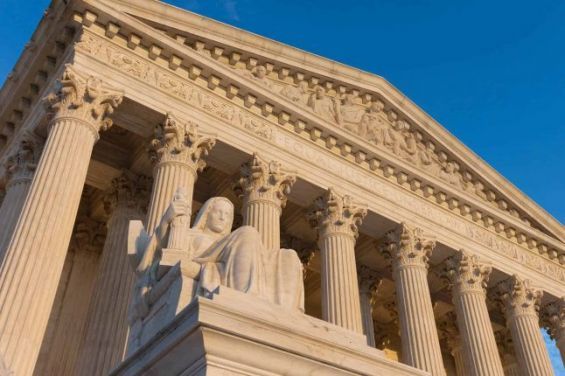Visual depictions of Prophet Mohammed were rare due to the common belief that rejected the practice. But this disagreement did not stop Western sculptors from producing representations of the Prophet of Islam.
While some of these depictions were deemed negative, others are seen as positive and/or neutral, including the one etched in marble on the United States Supreme Court building. As surprising as it may sound, the frieze of the 1930s building lists Prophet Mohammed as one of the 18 greatest lawgivers in the history of humanity.
The piece of art that decorates the façade of the American Supreme Court, depicts the Prophet standing next to several historical figures, including the sixth king of the First Babylonian dynasty Hammurabi, who is known for his «Code», Chinese philosopher Confucius and Prophet Moses.
A sculpture to honor lawgivers
The frieze by American sculptor, Adolph Weinman, shows the prophet holding the Quran in one hand and a sword in the other one, while standing between Byzantine Emperor Justinian and Carolingian Charlemagne. Since its installation in 1935, the piece of marble depicting the Prophet has been standing there, in honor of lawgivers.

Indeed, to the United States Supreme Court, its frieze is mainly about rendering homage to figures that contributed to installing laws throughout the history of humanity and Prophet Mohammed is one of them. In an «information sheet» about the courtroom friezes, the Supreme Court recalled that «Cass Gilbert, architect of the Supreme Court Building, selected Adolph A. Weinman, a respected and accomplished Beaux-Arts sculptor, to design the marble friezes for the Courtroom».
«Weinman designed a procession of 'great lawgivers of history' for the south and north walls to portray the development of law», explained the Court, referring to the frieze that includes Prophet Mohammed.
According to the same document, the piece of art designed by Weinman depicts Prophet Mohammed holding the Quran, which «provides the primary source of Islamic Law», stressing that the prophet’s «teachings explain and implement Quranic principles».
And to make its intentions clear, the court wrote in the same document that «the figure is a well-intentioned attempt by the sculptor, Adolph Weinman, to honor Mohammed and it bears no resemblance to [the prophet]». It also signaled that «Muslims generally have a strong aversion to sculptured or pictured representations of their Prophet».
The same intentions were later emphasized in 1989 by former Associate Justice of the Supreme Court of the United States John Paul Stevens. The latter said that the «inclusion of lawgivers from a vast array of religious, secular and cultural traditions symbolized a respect for justice that transcends a particular creed».
«The addition of carvings depicting Confucius and Muhammad may honor religion, or particular religions, to an extent that the First Amendment does not tolerate. Placement of secular figures such as Caesar Augustus, William Blackstone, Napoleon Bonaparte and John Mar-hall alongside these three religious leaders, however, signals respect not for great proselytizers but for great lawgivers».
Offended by the Supreme Court frieze
Despite the Supreme Court’s good «intentions», the frieze stirred controversy among the Muslim community in the United States, especially during the 1990s. In 1997, the Council on American-Islamic Relations (CAIR) and members of the Muslim community voiced their disappointment against the marble figure.

Offended by the depiction of Prophet Mohammed, the group called for sandblasting the artwork. «We believe the court had good intention by honoring the Prophet», the group said. «We appreciate that, we want to be flexible, and we are willing to pay for the changes ourselves», CAIR added.
«If maybe they can sandblast out the face (…) we suggested they could replace it with a piece of marble with maybe a verse from the Quran or saying of the Prophet pertaining to justice and law», the same group suggested.
Unfortunately for CAIR, its request was rejected by the court, which believed that «altering the frieze would harm its artistic integrity». «The depiction of Muhammad was intended only to recognize him, among many other lawgivers, as an important figure in the history of law; it is not intended as a form of idol worship», wrote the US chief justice in a letter.
Refusing to alter the portray, the court accepted, however, to change the court’s literature suggesting that Mohammed is the «founder of Islam» instead of its prophet.





 chargement...
chargement...













